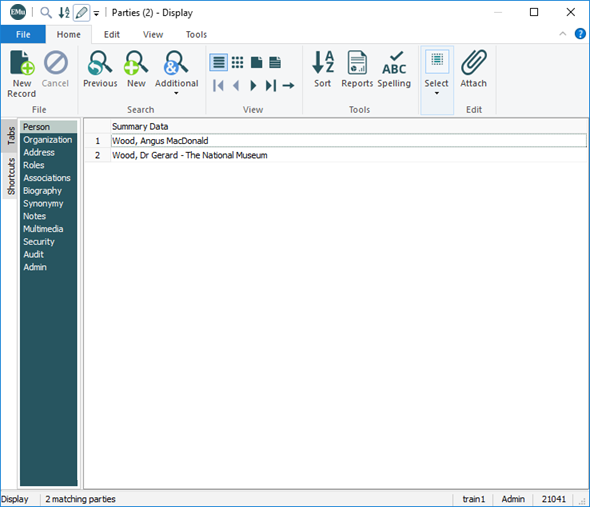As we have seen, there are two types of import: Typical and Custom. When Typical is selected on the Import Type screen of the Import Wizard, data is imported using the following default settings:
- Format and data validation is performed (see Validate Data screen for details).
- If a record in the data file attaches to another record (see Attachments screen for details):
- A search is performed of all existing records in the EMu database, which includes any records that have been created so far during the current import.
Note: Records in the import data file are processed sequentially: if record 5 attaches to record 6, no attachment will be made during the import as record 6 has not been created when record 5 is processed.
- If no match is found, a new record is added for the referenced record.
- If one record is found, an attachment is made to that record.
- If more than one match is found, the matching records are displayed so that the correct record can be selected manually.
- A search is performed of all existing records in the EMu database, which includes any records that have been created so far during the current import.
- All records are imported (see Records screen for details).
- A minimal log is generated containing setup options, results and a list of errors if any occur (see Report screen for details).
On the Import Type screen, click Next to continue.
Tip: Until the import commences by clicking Start on the Settings screen, you can return to a previous screen by clicking Back or cancel the import by clicking Close.
The Import Wizard leads you through the import, starting with the Import Identifier screen:

When new records are imported a unique System identifier is automatically generated and saved in any newly created records.
You have the option to add your own identifier in the Import identifier field.
System and Import identifiers are added to records created during the import. They are NOT added to existing records updated during the import: when the Import Wizard is used, new records get a System identifier and / or Import identifier, existing records do not.
The System identifier and Import identifier can be used to locate new records imported in a batch.
Tip:
The identifiers are recorded in the log file generated during the import (typically saved in the same location as the import data file).
System Identifier
A System identifier is read-only and unique. It is constructed from the importer's username and the date and time (24 hour clock) that the import commenced, in the format:
username-yymmdd-hhmm
It is useful for locating all new records imported in a specific batch.
Import Identifier
An Import Identifier does not need to be unique and it can be re-used with different import batches. It could be used, for example, to identify all records imported at any time by a particular user (enter the user's name in Import identifier for every set of records they import), e.g.:

How to use the identifiers
To locate imported records, enter a System or Import Identifier in the Import Details fields on a module's Admin tab and run the search:

In this example, all new records imported on 6 December 2017 at 16:25 will be located.
If we added an Import Identifier every time user Gerard Wood ran an import, we could then locate all new records imported by that user by entering Gerard Wood in Import Identifier: (Import Details):
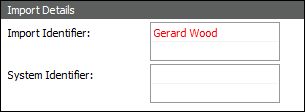
Note: Once created, both the Import identifier and System Identifier are read-only and cannot be modified.
Click Next to continue and display the Settings screen.
The Settings screen displays a list of the settings that will be used to import data from the selected file:
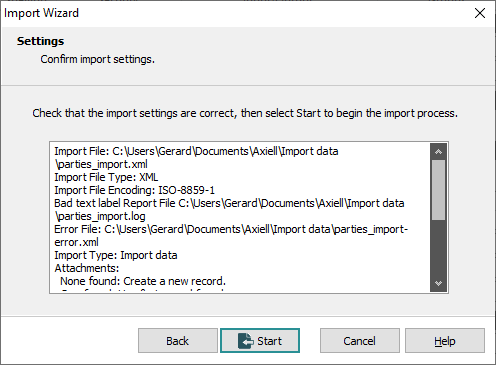
Review the settings:
- Click Back to return to a prior step and change the details
-OR-
Click Start to proceed with the import.
The Importing screen displays.
The Importing Screen displays and processing commences.
If no attachments to other records would be created during the import, or there is an exact match for any attachments created during the import, the import will be processed and a summary screen will display:

If an attachment would be created during the import and more than one matching record is located, you will need to identify which is the correct record to attach to.
When an attachment would be created during the import, a search is made for any matching records using details provided in the import data file.
Note: By default, not only are existing records searched, but any records that would be created by this import are searched as well.
If more than one record matches the details provided in the import data file, the Attachment Selection box will display with details to assist you to identify the correct attachment record:

In this case a record being imported seeks to attach to another Parties record; as there is more than one record that matches the Party name specified for the attachment it is necessary to identify which is the correct attachment record:
- Click OK.
The module containing the matching records will open and display all matching records, Parties in this case:
Note: Because records being imported could reference any of these matching records, it may be necessary to open the import data file, locate the record that is seeking to make this attachment and confirm that you have identified the correct attachment relationship. To facilitate this, the record number and line number of the record in the import data file are displayed in the Attachment Selection box.
What happens next depends on whether you are able to identify the correct attachment record:
- If you can identify the correct attachment record, click Attach on the Home tab of the Ribbon.
- If none of the listed records is the correct attachment, click
 in the module's Title bar.
in the module's Title bar. The Attachment Selection box displays with three options:
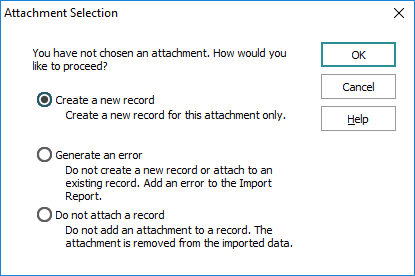
Select an option (the default is to create a new record) and click OK.
This process will repeat until each attachment is resolved, at which point the summary screen will display. In this case, the summary will include how many attachments were made:

If an error is indicated, you will need to check the data file and correct the error. Details here.
Tip: It is possible to bypass these steps with a Custom import.
Click Next to display the Import Complete screen.
The Import Complete screen displays a summary of the number of records processed:
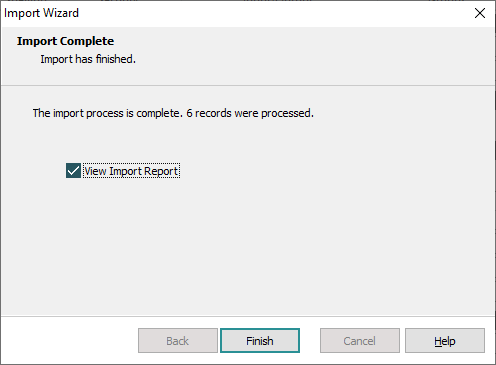
By default the View Import Report checkbox is checked.
Tip: If you do not wish to view the Import Report when you click Close, uncheck this box.
Click Finish to exit the Import Wizard and display the Import Report log:
Note: The Import Report file is typically saved in the same location as the import data file.
All records without errors are imported into EMu. Any records with errors are identified in the Import Report and are output to an error file (which is in the same format as the original import data file). Both files are typically saved to the same location as the original import data file.
The imported records will display in the module window.
Note: Any records listed or displaying prior to the import will be discarded: only the imported records will display.
A report will be generated during the import process. In the event of any errors, a data file will also be generated (filename_error.xml for example) in the same format as the file used in the data import. Typically these files are saved in the same location as the original import data file.
By default the report contains:
- A log of the settings and the success of the import.
- A description of any errors generated during the import.
The error file is a copy of the data file used for the import but containing only erroneous records. It can be used for iterative debugging. If there are any errors:
- Locate the error in the error file and fix it.
- Try the import again using the modified error file.
If there are still errors, another version of this file will be generated, and so on.
